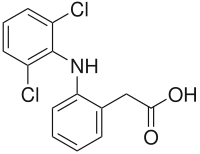
Photo from wikipedia
The balance between endothelial nitric oxide (NO) synthase (eNOS) activation and production of reactive oxygen species (ROS) is very important for NO homeostasis in liver sinusoidal endothelial cells (LSECs). Overexpression… Click to show full abstract
The balance between endothelial nitric oxide (NO) synthase (eNOS) activation and production of reactive oxygen species (ROS) is very important for NO homeostasis in liver sinusoidal endothelial cells (LSECs). Overexpression of cyclooxygenase-2 (COX-2), a major intravascular source of ROS production, has been observed in LSECs of cirrhotic liver. However, the links between low NO bioavailability and COX-2 overexpression in LSECs are unknown. This study has confirmed the link between low NO bioavailability and COX-2 overexpression by COX-2-dependent PGE2-EP2-ERK1/2-NOX1/NOX4 signalling pathway in LSECs in vivo and in vitro. In addition, the regulation of COX-2-independent LKB1-AMPK-NRF2-HO-1 signalling pathway on NO homeostasis in LSECs was also elucidated. The combinative effects of celecoxib on diminishment of ROS via COX-2-dependent and COX-2-independent signalling pathways greatly decreased NO scavenging. As a result, LSECs capillarisation was reduced, and endothelial dysfunction was corrected. Furthermore, portal hypertension of cirrhotic liver was ameliorated with substantial decreasing hepatic vascular resistance and great increase of portal blood flow. With the advance understanding of the mechanisms of LSECs protection, celecoxib may serve as a potential therapeutic candidate for patients with cirrhotic portal hypertension.
Journal Title: Journal of cellular and molecular medicine
Year Published: 2021
Link to full text (if available)
Share on Social Media: Sign Up to like & get
recommendations!